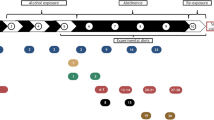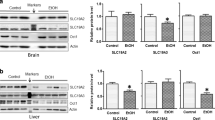Abstract
To determine if nutrition plays a role in ethanol withdrawal and alcohol-induced brain damage, the effects of a 4-day ethanol binge treatment using ethanol in a nutritionally complete liquid diet compared to ethanol mixed with water were studied. The nutritionally complete diet group (ETOH-diet) received a complete diet of sugars, proteins and fats with vitamins and minerals with approximately 53% of calories from ethanol while the nutritionally deprived group (ETOH-H2O) received 100% of calories from ethanol. No difference in withdrawal behavior was found between the ETOH-diet and ETOH-H2O groups during the 72-hour period studied. In addition, no difference was seen for serum levels of magnesium and zinc taken at last dose or following 72 h of withdrawal. Serum alanine aminotransferase (ALT) and ammonia were increased in both groups with ETOH-diet showing a greater increase in ALT than ETOH-H2O. Both groups showed damage in the olfactory bulb, perirhinal, agranular insular, piriform and lateral entorhinal cortical areas as well as hippocampal dentate gyrus and CA-3. Interestingly, the ETOH-diet group displayed more damage at last dose in the posterior dentate and CA-3 of hippocampus than did the ETOH-H2O group. This study suggests that nutritional components and total caloric intake do not effect behavior during ethanol withdrawal and that a nutritionally complete diet may increase ethanol-induced brain damage.
Similar content being viewed by others
References
Butterworth RF. Pathophysiology of alcoholic brain damage: Synergistic effects of ethanol, thiamin deficiency and alcoholic liver disease. Metab Brain Dis 10:1–8;1995.
Cartlidge D, Redmond AD. Alcohol and conscious level. Pharmacotherapy 44:205–208;1990.
Chandler LJ, Newson H, Sumners C, Crews FT. Chronic ethanol exposure potentiates NMDA excitotoxicity in cerebral cortical neurons. J Neurochem 60:1578–1581;1993.
Charness ME, Simon RP, Greenberg DA. Ethanol and the nervous system. N Engl J Med 321:442–452;1989.
Collins M, Corso T, Neafsey E. Neuronal degeneration in rat cerebrocortical olfactory regions during subchronic ‘binge’ intoxication with ethanol: Possible explanation for olfactory deficits in alcoholics. Alcohol Clin Exp Res 20:284–292;1996.
Collins MA, Zou J-Y, Neafsey EJ. Brain damage due to episodic alcohol exposure in vivo and in vitro: Furosemide neuroprotection implicates edema-based mechanism. FASEB J 12:221–230;1998.
Corso TD, Mostafa HM, Collins MA, Neafsey EJ. Brain neuronal degeneration caused by episodic alcohol intoxication in rats: Effects of nimodipine, 6,7-dinitro-quinozaline-2,3-dione, and MK-801. Alcohol Clin Exp Res 22:217–224;1998.
Crews FT. Alcohol and neurodegeneration. CNS Drug Rev 5;379–394;1999.
Crews FT, Braun CJ, Hoplight B, Switzer R III, Knapp DJ. Binge ethanol consumption causes differential brain damage in young-adolescent compared to adult rats. Alcohol Clin Exp Res, in press.
Crews FT, Morrow AL, Criswell H, Breese G. Effects of ethanol on ion channels. In: Bradley R, Harris R, Jenner P, eds. International Review of Neurobiology. San Diego, Academic Press, 283–367;1996.
de Olmos JS, Beltramino CA, de Olmos de Lorenzo S. Use of an amino-cupric-silver technique for the detection of early and semiacute neuronal degeneration caused by neurotoxicants, hypoxia, and physical trauma. Neurotoxicol Teratol 16:545–561;1994.
DiTraglia GM, Press DS, Butters N, Jernigan TL, Cermak LS, Velin RA, Shear PK, Irwin M, Schuckit M. Assessment of olfactory deficits in detoxified alcoholics. Alcohol 8;109–115;1991.
Flink EB, Stutuzman FL, Anderson AR, Lonig T, Fraser R. Magnesium deficiency after prolonged parenteral fluid administration and after chronic alcoholism complicated by delirium tremens. J Lab Clin Med 43:169–183;1954.
Frye GD, Ellis FW. Effects of 6-hydroxydopamine or 5,7-dihydroxytryptamine on the development of physical dependence on ethanol. Drug Alcohol Depend 2:349–359;1977.
Harding AJ, Wong A, Svoboda M, Kril JJ, Halliday GM. Chronic alcohol consumption does not cause hippocampal neuron loss in humans. Hippocampus 7:78–87;1997.
Harper CG, Kril JJ. Neuropathological changes in alcoholics. In: Hunt WA, Nixon SJ, eds. Alcohol-Induced Brain Damage. Rockville, National Institute on Alcohol Abuse and Alcoholism 22:39–70;1993.
Hunt WA, Nixon SJ. Alcohol-Induced Brain Damage, Research Monograph No. 22. Rockville, National Institute on Alcohol Abuse and Alcoholism, 1993.
Ibanez J, Herrero MT, Insausti R, Balzunegui T, Tunon T, Garcia-Bragado F, Gonzalo LM. Chronic alcoholism decreases neuronal nuclear size in the human entorhinal cortex. Neurosci Lett 183;71–74;1995.
Kesslak J, Profitt B, Criswell P. Olfactory function in chronic alcoholics. Percept Mot Skills 73;551–554;1991.
Knapp DJ, Crews FT. Induction of cyclooxy-genase-2 in brain during acute and chronic ethanol treatment and ethanol withdrawal. Alcohol Clin Exp Res 23:1–11:1999.
Knapp DJ, Saiers JA, Pohorecky LA. Observation of novel behaviors as indices of ethanol withdrawal-induced anxiety. Alcohol Suppl 2;489–493;1993.
Majchrowicz E. Induction of physical dependence upon ethanol and the associated behavioral changes in rats. Psychopharmacologia 43:245–254;1975.
Mendelson JH, La Dou J, Corbett C. Experimentally induced chronic intoxication and withdrawal in alcoholics. Part 2: Serum magnesium and glucose. Q J Stud Alcohol Suppl 2:108–116;1964.
Mendelson JH, Ogata M, Mello NK. Effects of alcohol ingestion and withdrawal on magnesium states of alcoholics: Clinical and experimental findings. Ann NY Acad Sci 135:919–933;1968.
Meyer JG, Urban K. Electrolyte changes and acid base balance after alcohol withdrawal, with special reference to rum fits and magnesium depletion. J Neurol 215:135–140;1977.
Obernier J, Crews FT. Corticolimbic circuit neurodegeneration induced by multiple day binge ethanol exposure. Alcohol Clin Exp Res 24:66A;2000.
Pfefferbaum A, Lim KO, Desmond JE, Sullivan EV. Thinning of the corpus callosum in older alcoholic men: A magnetic resonance imaging study. Alcohol Clin Exp Res 20:752–757;1996.
Robin RW, Long JC, Rasmussen JK, Albaugh B, Goldman D. Relationship of binge drinking to alcohol dependence, other psychiatric disorders, and behavioral problems in an American Indian tribe. Alcohol Clin Exp Res 22:518–523;1998.
Shear PK, Butters N, Jernigan TL, DiTraglia GM, Irwin M, Schuckit MA, Cermak LS. Olfactory loss in alcoholics: Correlation with cortical and subcortical MRI indices. Alcohol 9:247–255;1992.
Shepherd GM. The Synpatic Organization of the Brain. New York, Oxford University Press, 1998.
Sullivan EV, Rosenbloom MJ, Pfefferbaum A. Pattern of motor and cognitive deficits in detoxified alcoholic men. Alcohol Clin Exp Res 24:611–621;2000.
Suter C, Klingman W. Neurologic manifestations of magnesium depletion states. Neurology 4:691–699;1955.
Switzer R III, Majchrowicz E, Weight F. Ethanol-induced argyrophilia in entorhinal cortex of rat. Anat Rec 202:186a;1982.
Switzer RC III. Application of silver degeneration stains for neurotoxicity testing. Toxicol Pathol 28;70–83;2000.
Teplin LA, Abram KM, Michaels SK. Blood alcohol level among emergency room patients: A multivariate analysis. J Stud Alcohol 50:441–447;1989.
Urso T, Gavaler JS, Van Thiel DH. Blood ethanol levels in sober alcohol users seen in an emergency room. Life Sci 28:1053–1056;1981.
Victor M, Adams RD, Collins GH. The Wernicke-Korsakoff Syndrome and Related Disorders due to Alcoholism and Malnutrition. Philadelphia, Davis, 1989.
Author information
Authors and Affiliations
Rights and permissions
About this article
Cite this article
Crews, F.T., Braun, C.J., Ali, R. et al. Interaction of nutrition and binge ethanol treatment on brain damage and withdrawal. J Biomed Sci 8, 134–142 (2001). https://doi.org/10.1007/BF02255982
Issue Date:
DOI: https://doi.org/10.1007/BF02255982




